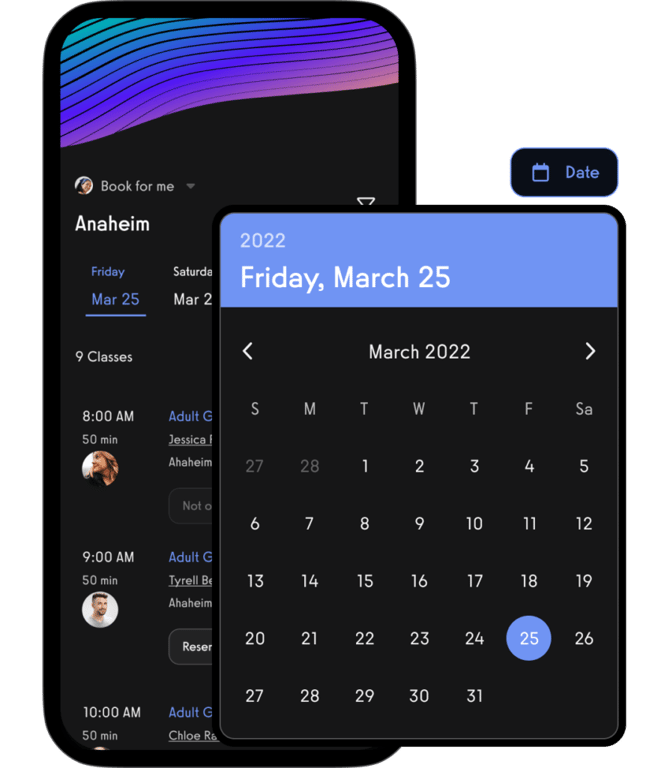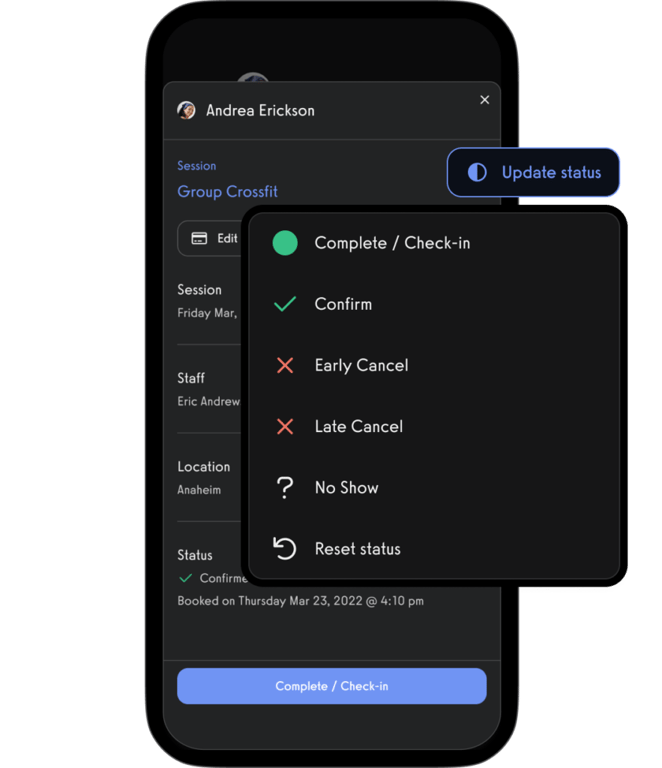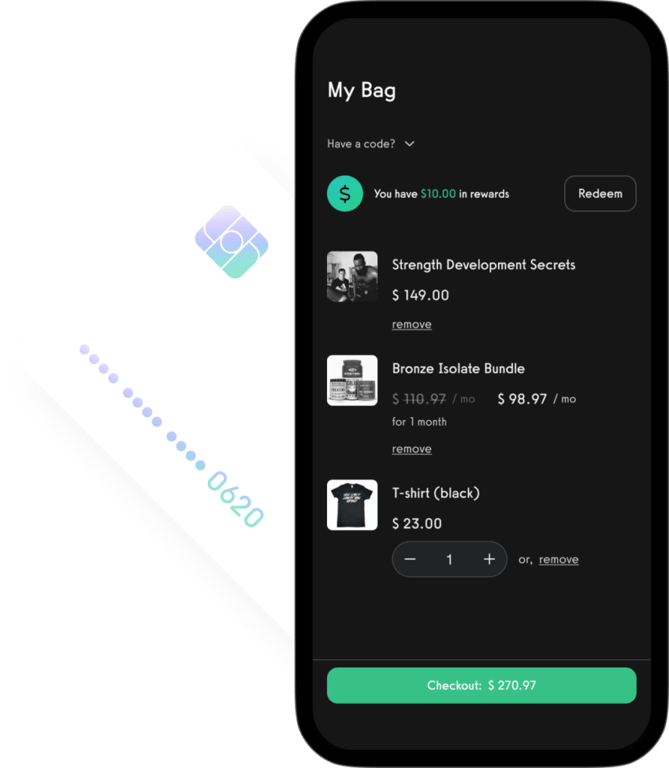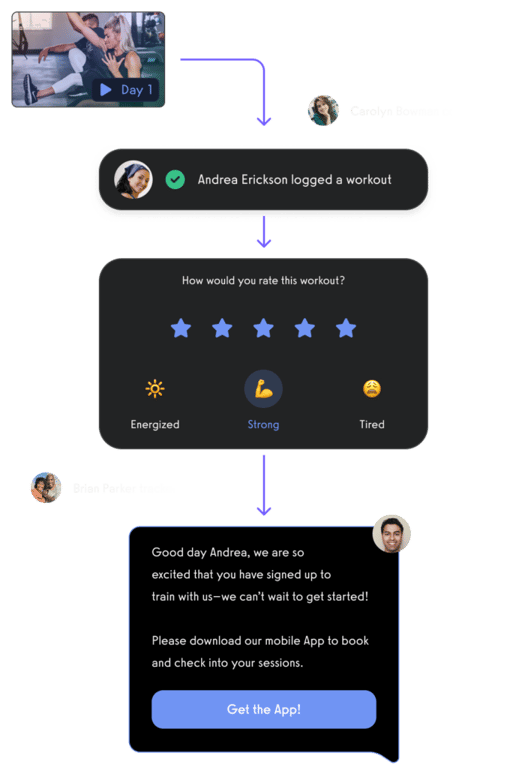Platform
Solutions
Industries
Compare
Resources
Posted by on January 27, 2024 — Updated on September 6, 2025
To start a boutique fitness studio, you need to conduct market research, select a suitable location, get required licenses and permits, and more. See why boutique fitness studio owners choose Exercise.com to manage clients, payments, scheduling, and marketing in one place.

Learn all about how to start a fitness studio business, how profitable boutique fitness studios can be, the cost to open a boutique fitness studio, and everything you need to run a successful boutique fitness studio. Starting a boutique fitness studio is a vibrant venture for entrepreneurs passionate about health and wellness. Discover how to open a boutique fitness studio, from startup costs to scaling, with Exercise.com powering your success.

When launching or scaling a boutique fitness center, one of the most underestimated decisions is selecting the right boutique fitness software. From client scheduling and branded mobile apps to contracts, reporting, POS, and performance tracking—every touchpoint should reflect your brand and elevate the client experience.
Too many new owners start with duct-taped solutions: a scheduling app here, billing software there, and maybe a clipboard sign-in sheet for good measure. But if your goal is to maximize your boutique fitness studio profit margin while scaling efficiently, these disconnected tools will limit you.
Instead, successful boutique studio owners use all-in-one boutique gym management platforms like Exercise.com. It’s built specifically for gym boutique operators, barre studio software needs, spin studio scheduling, and everything in between. Whether you’re focused on how to open a spin studio or how to start a group fitness studio, our tools support it all—under your own brand.
Need affordable booking software for boutique fitness studios? We’ve got that. Want to sell hybrid memberships that combine in-person personal training and on-demand group classes? Done. Want to build a signature challenge inside your branded app, track progress, upsell PT, and bill automatically? We do that better than anyone.
The boutique fitness sector has flourished, driven by consumers seeking specialized, community-centric workout experiences. Read on to learn how to open a fitness studio. If you’re wondering how to open a boutique fitness studio, it starts with careful planning, a strong business model, and the right technology to streamline operations. A fitness boutique studio thrives on specialization, offering unique classes and personalized experiences that keep members engaged.
Whether you’re designing a boutique fitness gym, launching a boutique fitness club, or developing a boutique personal training studio, success depends on having efficient scheduling, membership management, and payment processing. With Exercise.com, gym owners get a complete boutique fitness management solution that automates operations, integrates with branded apps, and supports online training, making it the best choice for managing a profitable boutique gym.

One of the biggest considerations when launching a boutique fitness business is its design and branding. A well-planned boutique fitness studio design and studio build gym can set the tone for the overall member experience. Exercise.com enhances this by providing customizable boutique fitness web design and connections to top boutique fitness website designers to create an engaging online presence. Whether you’re looking to establish a boutique gym franchise, work with a boutique gym designer, or implement boutique fitness solutions, our software ensures a seamless experience from sign-up to workout.
Since many gym owners ask, “Are boutique fitness studios profitable?”, the answer is yes—especially when managed efficiently with tools like Exercise.com. From boutique studio fitness scheduling to boutique personal training management, our platform offers everything needed to build, manage, and scale a successful boutique fitness business.
This boutique fitness studio business start-up guide outlines crucial steps for launching a successful boutique fitness studio and highlights why leveraging a platform like Exercise.com with the best boutique fitness studio software can simplify the process, making it more efficient and cost-effective than starting from scratch.
Offer easy boutique fitness studio booking online and in-person.

Handle boutique fitness studio class check-ins with ease.

Create and sell memberships, products, and digital offers.

Manage, message, and market to your leads and followers.

All from your very own custom branded fitness apps.




Opening a boutique studio is exciting, but it comes with unique challenges that differ from opening a traditional gym. Owners must juggle boutique gym billing software, fitness studio management, and compliance tasks like gathering the right documents needed to start a fitness studio. With narrow profit margins in the first year, you can’t afford inefficiencies. That’s why Exercise.com is the all-in-one solution that unifies scheduling, POS, billing, client engagement, and reporting into one seamless platform—helping boutique owners focus on growth instead of managing disconnected tools.
| Boutique Studio Type | Average Startup Cost | Pros | Cons | How Exercise.com Helps |
|---|---|---|---|---|
| Spin studio | $150,000–$250,000 | Strong demand, loyal community, scalable with class packs | High equipment costs, maintenance-heavy | Integrated spin studio booking software with automated billing and waitlist management |
| Barre studio | $80,000–$120,000 | Lower equipment costs, easy to scale classes | Smaller niche, heavy reliance on instructor quality | Barre studio software for attendance tracking, payments, and client retention |
| Functional training boutique | $100,000–$200,000 | Appeals to performance-driven clients | Requires variety of equipment, programming complexity | Custom workout builder tools + class scheduling in one dashboard |
| Pilates studio | $100,000–$300,000 (higher for reformers) | High-ticket clients, premium memberships | High setup costs, need specialized instructors | Unified pilates studio management software for scheduling, billing, and memberships |
| Boutique Fitness Model | Average Monthly Revenue | Profit Margin | Key Challenges | Exercise.com Advantage |
|---|---|---|---|---|
| Yoga boutique | $15,000–$40,000 | 10–20% | Seasonal fluctuations, reliance on memberships | Automated membership renewals and marketing campaigns keep revenue steady |
| Cycling studio | $25,000–$70,000 | 15–25% | High fixed costs (bikes, maintenance, rent) | Consolidated POS + equipment booking data gives clear financial picture |
| Strength/functional boutique | $20,000–$50,000 | 15–30% | Competition from CrossFit-style gyms | Custom-branded app builds community, differentiates your brand |
| Barre studio | $10,000–$30,000 | 10–20% | Instructor turnover, small class sizes | Instructor scheduling + payroll reports reduce admin headaches |
| Partnership Type | Benefits | Risks | Exercise.com Support |
|---|---|---|---|
| Corporate wellness | Recurring revenue, exposure to large employee groups | Complex contracts, invoicing headaches | Automated invoicing + B2B reporting tools |
| Local business collabs | Shared marketing, mutual growth | Unequal effort, misaligned brand values | Track referrals through CRM integrations |
| Healthcare partnerships | Referral stream from physical therapy or rehab centers | Compliance requirements, data tracking | Secure health tracking + reporting modules |
| University & sports teams | Long-term training contracts | Requires tailored programming | Custom programming features make scaling easy |
| Equipment Category | Cost Range | Preferred Suppliers | Pain Points | How Exercise.com Helps |
|---|---|---|---|---|
| Indoor cycling bikes | $1,500–$3,500 per bike | Fitness warehouse suppliers | Maintenance, upfront cost | Track usage + integrate class scheduling |
| Pilates reformers | $3,000–$6,000 each | Boutique suppliers | High capital expense | Boost ROI with automated class booking + waitlists |
| Functional training rigs | $5,000–$20,000 | Specialty equipment vendors | Space requirements | Maximize ROI by offering diverse classes easily scheduled |
| Barre equipment | <$500 per station | Boutique-focused providers | Instructor dependency | Streamline instructor scheduling and payroll reports |
Boutique owners need fitness studio strategy that balances revenue growth, class capacity, and operational control. Most studios struggle because they’re piecing together affordable booking software for boutique fitness studios, payment processors, and marketing tools. This leads to fragmented data, staff frustration, and missed opportunities. Exercise.com solves this by offering one platform that covers client management, scheduling, marketing automation, staff payroll, and advanced reporting.
When planning your studio, whether you’re evaluating how much does it cost to start a boutique fitness business, weighing pros and cons of boutique fitness studios, or deciding on the best equipment for boutique fitness studios, Exercise.com gives you the insights and software tools needed to build a profitable model from day one.
Exercise.com isn’t just software—it’s your growth partner in the boutique space. From launching with the right boutique fitness studio tools to scaling with B2B wellness partnerships, our platform helps you run your studio smarter, not harder.
If you’re opening a fitness studio and obsessing over lighting, mirrors, and playlists—but not your operating system—you’re stepping over dollars to pick up dumbbells. The difference between a crowded class and a cash-flow crunch is your fitness studio strategy: pricing architecture, capacity planning, staff utilization, retention levers, and the boutique fitness software powering it all.
You asked “how much does it cost to start a boutique fitness business,” but the tougher question is where the money disappears. The biggest leaks usually are:
How Exercise.com fixes it: set dynamic class capacities and waitlists, enforce late cancel/no-show fees, auto-escalate intro packs into term memberships, and recover failed payments with card updater + retries. Run profitability by class, coach, time block, and product in a single dashboard so boutique fitness studio profit margin becomes a managed KPI, not a monthly surprise.
Your “studio pattern” (the cadence of class types, intensities, and time slots) should map to data, not hunches. Launch with a 6-week test grid:
With Exercise.com, monitor fill rate, show rate, and first-to-fourth visit conversion by time and format, then auto-rebalance capacity. That’s boutique gym management with a feedback loop.
Founders ask, “what documents do I need to start a fitness studio?” Build a living bundle that doubles as operating guardrails:
Exercise.com stores digital waivers, attaches them to member profiles, and auto-prompts renewals so your documents needed to start a fitness studio are enforceable and searchable at scale.
Best-in-class isn’t about flashy hardware. It’s about the stack talking to itself. The best point-of-sale systems for boutique gyms do three things:
1) Reduce friction at the front desk (Apple/Google Pay, card on file)
2) Enforce business rules (late cancel fees, membership freezes, family profiles)
3) Feed clean data into forecasting
Exercise.com combines affordable booking software for boutique fitness studios with integrated POS, gift cards, credits, packs, and term memberships—no glue code. Forecast MRR, churn, and cohort LTV without exporting CSVs.
“What equipment options are best for boutique fitness studios?” and “can Fitness Warehouse supply equipment for boutique fitness studios?” are the wrong first questions. Start with programming: are you building studio boutique fitness around strength circuits, HIIT, barre, reformer, or how to open a spin studio? Your indoor cycling studio business plan may demand bikes with power metrics and fast service SLAs; your barre concept may need barres, small props, and flooring specs, not racks and plates.
Use demand density per class to stage inventory. Exercise.com’s Asset Management schedules rooms, rigs, lanes, and specialty gear (e.g., reformers or bikes), preventing double-bookings and surfacing utilization so you can answer “best equipment for boutique fitness studios” with your own data.
“Boutique fitness studios near me” searchers won’t convert on vibes. You need performance marketing that ladders to retention:
Exercise.com runs lead forms, drip campaigns, and SMS reminders out of the same system that runs your classes, so attribution is real. If you’re starting a fitness center from zero, use our templates from fitness business ideas and the deeper playbooks in how to start a fitness business.
Founders ask “how much do boutique owners make” and “how much does a boutique owner make.” Sensible targets once stabilized:
Exercise.com surfaces the leading indicators—intro-to-membership conversion, pack burn rate, freeze/cancel drivers—so boutique fitness studio profit margin is managed weekly, not discovered quarterly.
Thinking fitness studio franchising or a fitness boutique franchise? You’ll swap build speed for royalty drag and less brand control. Independents keep margin but must invent systems. With Exercise.com, independents get enterprise-grade fitness studio management—custom-branded apps, access control, staff payroll exports—without franchise constraints. If you do choose the franchise route, read how to start a gym franchise to diligence terms.
From day zero, you’ll juggle pricing, contracts, staffing, member comms, and compliance. Exercise.com offers onboarding that maps your packages, attendance rules, revenue recognition, and reporting—solutions for boutique fitness that go beyond software. Need a digital ramp before your lease? Pre-sell with how to start an online fitness business, or validate demand with how to start a fitness bootcamp business before heavy capex.
If you’re “opening a fitness studio” and want to avoid the common fate—great classes, broke business—treat business yoga style: disciplined, focused, repeatable. The fastest route from “what is a boutique fitness studio” to sustainable cash flow is a platform that runs everything end-to-end. Exercise.com is that platform: the CRM, scheduler, boutique studio software, POS, analytics engine, and branded app that turns first visits into long-term members and noisy dashboards into one clear plan.
Weave in supporting pages naturally where it strengthens the argument: how to open a gym, how to make money from fitness, how to start an online fitness business, how to start a fitness bootcamp business, and how to open a pilates studio. Keep your copy pain-point first, solution-second, and data-backed—then let the experience in-studio prove the promise.
Understanding your target market and competition is essential in the boutique fitness industry.
Exercise.com can assist in this initial phase by offering insights and trends within the fitness industry, guiding the development of your studio’s unique propositions.
Read More:
A well-crafted fitness gym business plan is crucial for your boutique fitness studio’s success.
Exercise.com’s business management tools simplify financial planning and marketing, from setting up a fitness studio POS system to managing class bookings and memberships.
Read More:
The right location is critical for a boutique fitness studio, impacting its accessibility and appeal.
Exercise.com’s platform can support studio owners in choosing a location by offering tools to integrate location-based marketing strategies, driving local engagement and membership sign-ups.
Read More: How to Choose the Best Location for a Gym
Navigating legal requirements is a critical step in establishing your boutique fitness studio.
While you need to keep track of your own fitness studio licensing requirements, Exercise.com’s software aids in managing and storing important documents like waivers, assessments, invoices, and other member and staff documents you may need e-signed, ensuring organization and easy access.
Read More:
Creating an inviting and functional studio space is essential for fostering a motivating workout environment.
Exercise.com’s custom-branded gym app extends this ambiance online, providing a seamless brand experience from the physical studio to the digital space, where clients can access classes, schedules, and more.
Read More:
Advanced technology can enhance the operation and client experience of your boutique fitness studio.
The custom-branded app by Exercise.com not only reflects your studio’s brand but also provides a platform for online classes, bookings, and community engagement, enriching the client experience and expanding your studio’s reach.
Read More:
Effective fitness studio marketing is crucial for attracting and retaining clients.
Exercise.com’s platform supports marketing efforts by offering gym growth packages with gym refer-a-friend technology, automated gym marketing campaigns, as well as integrating with popular marketing tools and providing analytics to measure the effectiveness of your campaigns, ensuring a data-driven marketing strategy.
Read More:
A successful fitness studio launch can set a positive tone for your boutique fitness studio’s future.
With Exercise.com, you can manage event registrations, promotional offers, and communication with attendees, ensuring a smooth and successful studio launch.
Read More:
Launching a boutique fitness studio involves careful planning, understanding the market, and strategic use of technology. By following these steps and leveraging platforms like Exercise.com, you can streamline the process, enhance the client experience, and establish a thriving boutique fitness studio. Exercise.com’s comprehensive suite of tools supports every aspect of running a successful studio, from market research to the grand opening and beyond, making it an ideal partner for aspiring studio owners.


Before you order your first piece of equipment, it’s crucial to ask: what documents do I need to start a fitness studio? Local permits, lease agreements, insurance policies, and operational agreements are table stakes—but that’s just the start. Your boutique fitness studio business plan needs to address client acquisition strategy, B2B wellness partnerships, fitness studio franchising considerations, and whether your market supports high-end or high-volume positioning.
Pair that with smart supplier relationships. What are the preferred suppliers for boutique fitness studios? While many studio boutique fitness founders look to options like Fitness Warehouse, it’s also worth evaluating vendors based on integration with your tech stack. For example, using Exercise.com lets you manage asset bookings, class scheduling, and even integrate with smart equipment tracking.
And if you’re building a boutique health club from scratch, you’ll want a platform that scales. Whether you’re planning for 1 location or 10, your studio boutique software needs to support complex scheduling, hybrid models, mobile check-ins, flexible membership plans, and recurring billing—without duct tape or dev time.
If you’ve been approached by local employers, health plans, or corporate wellness brokers, you’ve likely wondered: are B2B wellness partnerships worth it for boutique studios?
Short answer: yes—if your backend can handle the operational complexity.
Boutique fitness studio owners who succeed in B2B partnerships rely heavily on features like flexible invoicing, segmented membership types, usage-based billing, and detailed reporting. These partnerships can massively increase recurring revenue while reducing churn. Exercise.com lets you run B2B contracts side-by-side with retail memberships, without operational headaches.
Whether it’s onboarding 50 employees from a single company or setting up B2B custom-branded wellness portals, our team helps boutique fitness studio brands implement strategies and features that drive enterprise-level results with boutique-level charm.
If you’re thinking, “how do I start a fitness center that stands out,” or “what fitness studio strategy can maximize growth and retention,” then you need a playbook, not guesswork. We’ve curated the best resources to help you build, launch, and scale your brand:
If you’re building the next Uplift Fitness Boutique or developing your own version of Creed Fitness Studio, don’t settle for software that wasn’t built for your model. Get the right tools now so your systems won’t break when your business takes off.
Opening a boutique gym typically requires an initial investment ranging from $50,000 to $500,000, depending on the location, size, and level of equipment and finishes desired. Start-up costs include lease or purchase of space, equipment, interior design, and initial marketing efforts. If you are seeking funding or need a gym loan then learning how to create a boutique gym business plan is important, but otherwise, your time is better spent actually starting a boutique gym rather than creating a boutique gym business plan.
Read More: Cost to Open a Gym
Equipment for a boutique fitness studio varies by the type of workouts offered but may include cardio machines, free weights, yoga mats, resistance bands, Pilates reformers, and specialized gear like spin bikes or boxing bags, tailored to the studio’s specific fitness niche.
Read More: What equipment is needed to start a boutique fitness studio?
To open a boutique fitness studio, you’ll need several essential documents to protect your business and operate legally. These include a business license, liability waivers, a certificate of occupancy, zoning approval, and your EIN for tax purposes. If you’re offering specialized services like group fitness or personal training, you may also need state-specific certifications or permits. One of the most overlooked pieces is ensuring you have robust studio management systems in place, which is why using Exercise.com helps simplify legal compliance with customizable digital waivers, membership agreements, and PAR-Q forms.
The benefits of launching a boutique fitness studio include premium pricing potential, deeper community connection, and brand differentiation. However, there are also challenges—limited square footage, dependency on local market saturation, and higher member acquisition costs. Boutique fitness owners need to build in recurring revenue streams and digital infrastructure. With tools from Exercise.com like integrated billing, branded mobile apps, and automated marketing, you can offset some of the biggest pain points facing boutique studios today.
The cost of opening a boutique fitness studio typically ranges between $50,000 to $250,000 depending on the concept, location, and equipment needed. Indoor cycling studios, for example, often require higher startup capital than a yoga or barre studio. For a breakdown of startup expenses, check out this deep dive into the cost of opening a gym. Whether you’re bootstrapping or planning to scale quickly, Exercise.com is the best boutique gym software to streamline operations from day one.
Boutique fitness studio tools should support class scheduling, recurring billing, performance tracking, and member engagement—all under your brand. Exercise.com stands out as the most complete boutique gym management solution, offering integrated apps, automated client communications, and seamless POS systems. For niche studios like barre, spin, or HIIT, Exercise.com also handles instructor scheduling, assessments, and even workout programming with drag-and-drop tools.
Preferred suppliers vary by niche. For example, spin studios often partner with companies like Stages or Schwinn, while strength-based boutique gyms rely on providers like Rogue or Fitness Warehouse. The key is ensuring equipment suppliers meet your brand’s design and functional standards. Using Exercise.com’s all-in-one platform ensures you can layer in equipment booking, asset tracking, and maintenance reminders without extra software.
Understanding how to run a gym studio pattern means creating an operational flow that maximizes class throughput without overcrowding. Your layout must reflect your programming—whether you’re offering circuit-based training, yoga, or cycling. A boutique gym layout should guide members from check-in (ideally via app) to class, locker area, and exit with minimal friction. With Exercise.com, your layout becomes smarter, with QR code check-ins, studio occupancy management, and class capacity auto-updates to keep things running efficiently.
Yes, B2B wellness partnerships can drive significant recurring revenue and brand exposure. Corporate wellness programs and partnerships with local businesses often offer high retention and large group access. Exercise.com enables you to manage multiple billing structures, branded portals for corporate partners, and even automated performance reporting—making it easy to scale your B2B revenue stream. See how the benefits of B2B wellness partnerships for boutique studios can transform your profit margins.
Whether you’re building a spin studio, yoga concept, or hybrid strength/cardio space, the best boutique fitness studio business model is subscription-based with tiered memberships, upsells (like workshops and merch), and digital class options. Using Exercise.com for online fitness business allows you to build and manage both in-person and virtual offerings under one system with zero tech headaches.
Earnings vary depending on niche, location, and overhead, but boutique studio profit margins are often higher than big-box gyms. A well-run boutique gym can net $50,000–$150,000 annually, with top earners exceeding $250,000. But this depends on strategic use of tools like Exercise.com, which helps studio owners optimize revenue per square foot with tools for upselling, automating renewals, and creating scalable online training programs.
The most successful fitness studio strategies focus on brand identity, instructor consistency, community-building, and tech-enabled convenience. Boutique studios win when they deliver a hyper-personalized experience. With Exercise.com, you can build branded fitness apps, track client goals, send personalized workout reminders, and even run loyalty programs—all critical differentiators in the boutique fitness studio market.
Owning a fitness studio can be profitable, especially in the boutique segment, where personalized experiences can command higher membership fees. Profitability depends on effective boutique fitness management, unique offerings, and strong customer retention strategies.
Read More: How profitable is owning a gym?
A high-value high-price fitness studio typically offers specialized, premium fitness experiences with personalized services, state-of-the-art equipment, and luxurious amenities, justifying higher membership fees. It focuses on exclusivity, individual attention, and unique class offerings. In contrast, a high-value low-price gym provides good quality services and facilities at more affordable prices, focusing on accessibility and broad appeal. The key difference lies in the exclusivity, personalized experiences, and amenities offered, impacting the pricing structure and target audience.
Read More: Gym Pricing Strategy
People pay for expensive gyms because they value the premium experience, including specialized workout programs, personalized attention from top trainers, luxurious amenities (like high-end locker rooms, spa services, and health bars), and the sense of community and exclusivity. These gyms often offer a more holistic wellness approach, incorporating fitness, nutrition, and relaxation in one place, providing a comprehensive lifestyle experience that justifies the higher cost.
The most important features and amenities a boutique fitness studio needs include:
Incorporating these boutique fitness studio features and amenities can significantly enhance the value of a boutique fitness studio, attracting and retaining members willing to pay premium prices for a superior fitness experience.
Read More: Best Gym Features and Amenities
To start your own workout studio, conduct market research, choose a fitness niche, develop a business plan, secure financing, find a suitable location, purchase equipment, hire qualified staff, and implement a strong marketing strategy to attract and retain clients.
The boutique fitness studio market has seen significant growth, valued at several billion dollars globally. It’s characterized by high consumer demand for specialized, community-oriented fitness experiences, with a trend toward personalized and small-group training sessions.
Boutique gym owners’ income can vary widely, with some making over $100,000 annually. Profits depend on the gym’s location, the uniqueness of the concept, membership rates, and effective cost management.
Read More: How much do gym owners make?
A boutique gym is characterized by its specialized focus on a specific fitness niche (like yoga, cycling, or Pilates), smaller, more intimate class sizes, personalized attention, and often, a strong sense of community among members.
To make a boutique fitness studio app, define your app’s features and functionality, design the user interface, hire a developer or use an app development platform, test the app, and launch it on app stores. Platforms like Exercise.com offer customizable app solutions specifically for fitness businesses.
Read More: How to Make a Fitness Studio App
The best place to start a boutique fitness studio is in a location with a high target demographic density, good visibility, convenient access, and sufficient space for the planned activities. Affluent urban or suburban areas often provide a solid customer base.
Read More: Best Locations for Gyms
To start a boutique fitness studio, you need a clear concept, a business plan, financing, a suitable location, the right equipment, qualified instructors, a boutique fitness marketing strategy to attract clients, and a management system to handle scheduling and memberships. Starting a fitness studio takes hard work and determination. Learning how to start your own fitness studio takes time, but the best time to start is now!
Boutique fitness is popular due to its personalized approach, unique and specialized class offerings, community feel, and the high-quality, immersive fitness experiences it provides, often in a luxurious or highly tailored environment.
Boutique gyms are popular because they offer specialized fitness experiences, create strong community bonds among members, provide personalized attention from instructors, and often feature unique, high-end amenities and class formats.
Boutique gyms offer specialized fitness classes (like spin, yoga, or HIIT), personalized coaching, small class sizes for more individual attention, high-end amenities, and a community atmosphere that fosters member engagement and loyalty.
There are thousands of boutique fitness studios in the US, with the number continuously growing as consumer demand for specialized, high-quality fitness experiences increases.
An example of a boutique gym is SoulCycle, known for its specialized indoor cycling classes, high-energy environment, and strong community, or Pure Barre, focusing on barre workouts that combine elements of ballet, Pilates, and yoga.
Boutique fitness began gaining popularity in the early 2000s, with the rise of specialized studios offering unique, focused fitness experiences, differentiating themselves from traditional, all-encompassing gyms. Now there are a number of boutique fitness franchises and starting a boutique fitness studio franchise concept is a possibility for many fitness entrepreneurs.
The number of members at most gyms can vary widely, but boutique fitness studios typically have a few hundred to a few thousand members, depending on their size, location, and the exclusivity of their offerings.
Read More: How many members do most gyms have?
At a fitness studio, consider selling branded apparel, fitness gear (like mats, water bottles, and resistance bands), nutritional supplements, healthy snacks, and merchandise that aligns with your brand and your members’ fitness goals.
The best boutique fitness studio software is one that offers comprehensive features tailored to the needs of boutique studios, such as Exercise.com, which provides tools for class scheduling, member management, workout programming, and e-commerce.
Read More: Best Boutique Fitness Studio Software
Exercise.com can help run a successful boutique fitness studio by offering customizable software solutions that manage class scheduling, client engagement, workout programming, and e-commerce. Its all-in-one platform is designed to streamline operations, enhance member experience, and drive business growth, making it an invaluable tool for boutique fitness studio owners.


 Tyler Spraul
Tyler Spraul